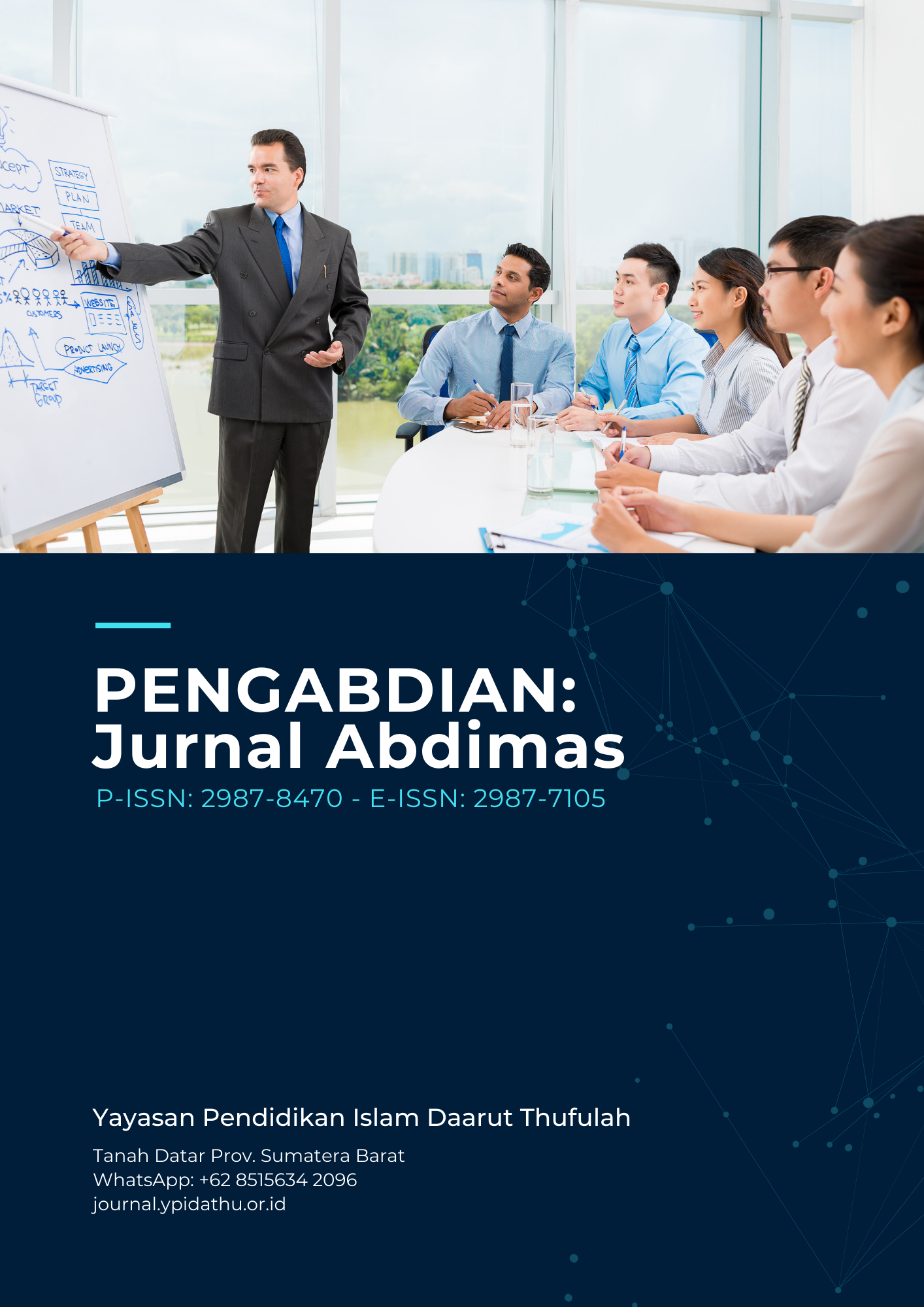Abstract
Background. The thesis focuses on community service (PkM) conducted by the Ministry of Health Poltekkes institutionally, specifically in the village of Kota Lama II, Secanggang District, Langkat Regency. The study addresses the inadequate access to clean water and poor sanitation conditions in Mr. Mujadi's house, which is among the families included in the PKH (Program Keluarga Harapan) - a conditional cash transfer program in Indonesia.
Purpose. The purpose of this community service project is to improve the living conditions of Mr. Mujadi's household by addressing their water and sanitation issues. The project aims to apply science, technology, and art (IPTEKS) through a direct scientific approach to provide sustainable access to clean water and improve sanitation facilities.
Method. The objective of this qualitative research is to explore and understand the application of appropriate technology for clean water supply in Kota Lama II Village, Secanggang District, Langkat Regency. The study aims to gain in-depth insights into the experiences, perceptions, and challenges related to the use of appropriate technology for clean water.
Results. The results obtained at the end of community service activities in Kota Lama Village II, Secanggang District, Langkat Regency, were built 1 unit of Infiltration galleries. The implementation stages include the initial survey, making Infiltration galleries, compiling filter media, and socializing about clean water and operations and maintenance of Infiltration galleries.
Conclusion. Well, water filtered from wells using Infiltration galleries looks clearer and cleaner, odorless and tasteless. This has met the requirements for clean water physically and has met the sanitation aspect.
Full text article
References
Amado-Alonso, D., León-del-Barco, B., Mendo-Lázaro, S., Sánchez-Miguel, P., & Iglesias Gallego, D. (2019). Emotional Intelligence and the Practice of Organized Physical-Sport Activity in Children. Sustainability, 11(6), 1615. https://doi.org/10.3390/su11061615
Anoum, P., Arifa, F., & May, C. (2022). Strategies to Increase the Motivation of Tahfidz Al-Quran. Journal International Inspire Education Technology, 1(2), 74–85. https://doi.org/10.55849/jiiet.v1i2.88
Baig, U., Faizan, M., & Waheed, A. (2022). A review on super-wettable porous membranes and materials based on bio-polymeric chitosan for oil-water separation. Advances in Colloid and Interface Science, 303, 102635. https://doi.org/10.1016/j.cis.2022.102635
Bridge, P., & Bridge, R. (2019). Artificial Intelligence in Radiotherapy: A Philosophical Perspective. Journal of Medical Imaging and Radiation Sciences, 50(4), S27–S31. https://doi.org/10.1016/j.jmir.2019.09.003
Demina, D., Rexy, T., & Danyl, A. (2022). The Use of Quranic Learning Strategies Through the Wafa Method in Elementary Schools. Journal International Inspire Education Technology, 1(2), 62–73. https://doi.org/10.55849/jiiet.v1i2.91
Dewi S, Y., Rasyid Umar, A., Ali Khan, A., & Aziz, A. (2022). Fun Arabic Teaching With Media Song For Early Child Education School. Journal International of Lingua and Technology, 1(2), 140–156. https://doi.org/10.55849/jiltech.v1i2.80
Dianovi, A., Siregar, D., Mawaddah, I., & Suryaningsih, S. (2022). Guidance and Counselling in Education. World Psychology, 1(2), 27–35. https://doi.org/10.55849/wp.v1i2.95
Fdez-Sanromán, A., Pazos, M., Rosales, E., & Sanromán, M. A. (2020). Unravelling the Environmental Application of Biochar as Low-Cost Biosorbent: A Review. Applied Sciences, 10(21), 7810. https://doi.org/10.3390/app10217810
Firman, F., Alef, R., & Eric, M. (2022). Use Of Zoom Meeting Applications to Memorize the Qur’an Online. Journal International Inspire Education Technology, 1(2), 99–110. https://doi.org/10.55849/jiiet.v1i2.92
Gabriela, M., Cicerchi, G., Colin, H., & Ana, C. (2022). The Role of Parents in Helping Arabic Teachers to Improve Students’ Vocabulary. Journal International of Lingua and Technology, 1(2), 131–139. https://doi.org/10.55849/jiltech.v1i2.83
Haghighi Mood, S., Pelaez-Samaniego, M. R., & Garcia-Perez, M. (2022). Perspectives of Engineered Biochar for Environmental Applications: A Review. Energy & Fuels, 36(15), 7940–7986. https://doi.org/10.1021/acs.energyfuels.2c01201
Hartini, S., Alie, E., & March, J. (2022). The Relationship Between Authoritarian Parenting and Aggressive Behavior of Adolescents in Nagari Bungo Tanjung. World Psychology, 1(2), 18–26. https://doi.org/10.55849/wp.v1i2.98
Hikmah, D., Petoukhoff, G., & Papaioannou, J. (2022). The Utilization Of The Animiz Application As A Media For Arabic Language Learning On Students. Journal International of Lingua and Technology, 1(2), 157–171. https://doi.org/10.55849/jiltech.v1i2.84
Ilham, S., Adelir, D., & Delr, Q. (2022). The Benefits of Whatsapp as a Medium in Depositing Memorization of the Qur’an. Journal International Inspire Education Technology, 1(2), 86–98. https://doi.org/10.55849/jiiet.v1i2.90
Kartel, A., Charles, M., Xiao, H., & Sundi, D. (2022). Strategies for Parent Involvement During Distance Learning in Arabic Lessons in Elementary Schools. Journal International of Lingua and Technology, 1(2), 99–113. https://doi.org/10.55849/jiltech.v1i2.82
Keshav, M., Julien, L., & Miezel, J. (2022). The Role Of Technology In Era 5.0 In The Development Of Arabic Language In The World Of Education. Journal International of Lingua and Technology, 1(2), 79–98. https://doi.org/10.55849/jiltech.v1i2.85
Kumar, R., Ghosh, A. K., & Pal, P. (2020). Synergy of biofuel production with waste remediation along with value-added co-products recovery through microalgae cultivation: A review of membrane-integrated green approach. Science of The Total Environment, 698, 134169. https://doi.org/10.1016/j.scitotenv.2019.134169
Najeed, M. A., Hakonarson, C., & Mentch, G. (2022). Learning Tahfiz with Talaqqi Method Using Whatsapp Application. Journal International Inspire Education Technology, 1(2), 125–137. https://doi.org/10.55849/jiiet.v1i2.86
Nopiana, N., Egie, J., & Mers, O. (2022). The Impact of Internet Addiction on Introvert Personality. World Psychology, 1(2), 1–17. https://doi.org/10.55849/wp.v1i2.97
Papaioannou, E. H., Mazzei, R., Bazzarelli, F., Piacentini, E., Giannakopoulos, V., Roberts, M. R., & Giorno, L. (2022). Agri-Food Industry Waste as Resource of Chemicals: The Role of Membrane Technology in Their Sustainable Recycling. Sustainability, 14(3), 1483. https://doi.org/10.3390/su14031483
Qureshi, M., Mahdiyyah, D., Mohamed, Y., & Ardchir, M. (2022). Scale For Measuring Arabic Speaking Skills In Early Children’s Education. Journal International of Lingua and Technology, 1(2), 114–130. https://doi.org/10.55849/jiltech.v1i2.81
Rahmah, A., Rouns, E., & Luck, A. (2022). The Effect of Self-Development Program for Improving Independence in Defective Students in SLB N 1 Lima Kaum Batusangkar. World Psychology, 1(2), 46–53. https://doi.org/10.55849/wp.v1i2.96
Rohmalimna, A., Yeau, O., & Sie, P. (2022). The Role of Parental Parenting in the Formation of the Child’s Self-Concept. World Psychology, 1(2), 36–45. https://doi.org/10.55849/wp.v1i2.99
Safitri, S., Alii, M., & Mahmud, O. (2022). Murottal Audio as a Medium for Memorizing the Qur’an in Super-Active Children. Journal International Inspire Education Technology, 1(2), 111–124. https://doi.org/10.55849/jiiet.v1i2.87
Zhu, X., & Jassby, D. (2019). Electroactive Membranes for Water Treatment: Enhanced Treatment Functionalities, Energy Considerations, and Future Challenges. Accounts of Chemical Research, 52(5), 1177–1186. https://doi.org/10.1021/acs.accounts.8b00558
Authors
Copyright (c) 2023 restu auliani, Riyanto Suprawihadi, Buschhaus Avinash

This work is licensed under a Creative Commons Attribution-ShareAlike 4.0 International License.





